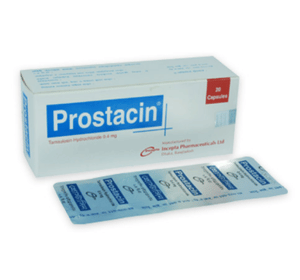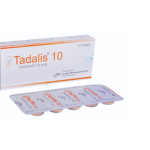Prostacin(Tamsulosin)
Therapeutic Group: Urological
Presentation

Prostacin Capsule: Each modified release capsule contains Tamsulosin Hydrochloride USP 0.4 mg (as modified release Pellets).
Description
Tamsulosin, a selective alpha1 adrenoceptor blocking agent, exhibits its selectivity for alpha1A adrenoceptors in human prostate. Blockade of these adrenoceptors can cause smooth muscle in the bladder neck and prostate to relax, resulting in an improvement in urine flow rate and a reduction in symptoms of BPH. Absorption of Tamsulosin Hydrochloride capsules 0.4 mg is essentially complete (90%) following oral administration under fasting condition. The time to maximum concentration (Tmax) is reached by four to five hours under fasting conditions and by six to seven hours when administered with food. Tamsulosin Hydrochloride is extremely bound to human plasma protein (94% to 99%). Tamsulosin Hydrochloride is extensively metabolized by cytochrome P 450 enzymes in the liver and less than 10% of the dose is excreted in urine as unchanged form. Following intravenous or oral administration of an immediate-release formulation the elimination half-life of Tamsulosin Hydrochloride in plasma ranges from five to seven hours. Because of the absorption rate controlled pharmacokinetics with capsules, the apparent half-life of the Tamsulosin Hydrochloride is approximately 9 to 13 hours in healthy volunteers and 14 to 15 hours in the target population.
Indications
Prostacin (Tamsulosin Hydrochloride) capsules are indicated for the treatment of the signs and symptoms of Benign Prostatic Hyperplasia (BPH).
Dosage & Administration
1 (one) capsule once daily is recommended as the dose for the treatment of the signs and symptoms of BPH. It should be administered approximately one-half hour following the same meal each day. For those patients who fail to respond to the 0.4 mg dose after two to four weeks of dosing, the dose of capsules can be increased to 0.8 mg once daily. If capsules administration is discontinued or interrupted for several days at either the 0.4 mg or 0.8 mg dose, therapy should be started again with the 0.4 mg once daily dose.
Side Effects
The following adverse reactions have been reported during the use of Tamsulosin: dizziness, abnormal ejaculation, and less frequently (1-2%) headache, asthenia, postural hypotension, palpitations and rhinitis. Gastrointestinal reactions such as nausea, vomiting, diarrhoea, and constipation can occasionally occur. Hypersensitivity reactions such as rash, pruritus, and urticaria can occur occasionally. As with other alpha-blockers, drowsiness, blurred vision, dry mouth or oedema can occur. Syncope has been reported rarely, and there have been very rare reports of angioedema and priapism.
Precautions
Hypersensitivity to Tamsulosin Hydrochloride. A history of orthostatic hypotension; severe hepatic insufficiency. As with other alpha1 blockers, a reduction in blood pressure can occur in individual cases during treatment with Tamsulosin, as a result of which, rarely, syncope can occur. At the first signs of orthostatic hypotension (dizziness, weakness) the patient should sit or lie down until the symptoms have disappeared. And they should be cautioned to avoid situations where injury could result (like driving, operating machinery or performing hazardous tasks). Before therapy with Tamsulosin is initiated the patient should be examined in order to exclude the presence of other conditions which can cause the same symptoms as Benign Prostatic Hyperplasia. Digital rectal examination and when necessary determination of Prostate Specific Antigen (PSA) should be performed before treatment and at regular intervals afterwards. The treatment of severely renal impaired patients (creatinine clearance is less than10ml/min) should be approached with caution as these patients have not been studied. Caution should be exercised in porphyria or allergic reaction to this or any other medicine.
Use in Pregnancy & Lactation
Tamsulosin Hydrochloride capsules are not indicated for use in women.
Over Dose
As overdose of Tamsulosin Hydrochloride capsules lead to hypotension to support the cardiovascular system is of first importance,restoration of blood pressure and normalization of heart rate may be accomplished by keeping the patient in supine position. If this measure is inadequate, then administration of intravenous fluid should be considered. Measures, such as emesis, can be taken to impede absorption. When large quantities are involved, gastric lavage can be applied and activated charcoal and an osmotic laxative, such as sodium sulphate, can be administered.
Commercial Pack
Prostacin Capsule: Each box contains 3 Alu-Alu blister strips of 10 capsules.



